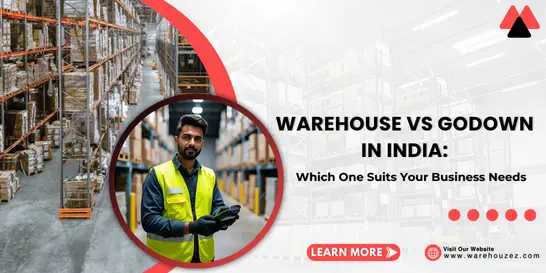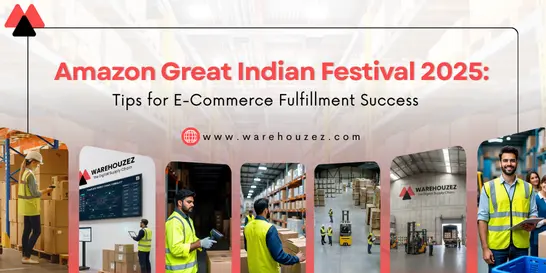AI & Machine Learning: How Is It Changing Warehousing services?
AI & Machine Learning: How Is It Changing Warehousing services?
Modern warehouses as we know them today have developed. With the help of logistics planning in artificial intelligence, businesses can satisfy the demands of always-on eCommerce, the requirement to manage a sizable number of SKUs with fewer mistakes, and the need for quicker reaction times. In this blog, we have thrown light on how artificial intelligence is changing warehouse operations, both in the previous several years and in the years to come. With quicker reactions to logistical needs for staff and material items, warehouse management will become more adaptable and scalable in terms of coming up with new solutions for increased volume and flow of products.
Understanding Artificial Intelligence
Artificial intelligence (AI) tries to create machines that can replicate human behaviors and reactions as accurately as possible. It is capable of carrying out human-like functions like judgment, speech recognition, visual perception, and language translation. The most advanced system now in use is AI integrated into a piece of machinery or equipment. Giving a computer or piece of machinery instructions that may need to be divided into smaller processes is the traditional technique. The neural network does not require this input for operation. Instead, it picks up skills and can even handle challenges on its own.
AI and machine learning are frequently used interchangeably. But it's a subgroup whose main goal is to develop self-learning algorithms and data analysis techniques to learn how to execute a specific task well. You may include logistics planning in artificial intelligence into your strategy by being aware of what it can and cannot achieve. The next step is to appoint qualified candidates to adapt your company's environment and data to automate your processes and give you quick access to important insights.
What is the Need for AI in Warehouse Management?
Machine learning, natural language processing, robotics, and computer vision are a few of the sub-technologies that artificial intelligence in logistics uses to create value in the warehouse. AI is a revolutionary technology. However, it would be incorrect to believe that only blue-chip corporations and major international IT businesses may gain from AI. In the end, artificial intelligence will change every industry and corporation.
Some of the ways by which AL can help in warehouse management are listed below:
Increase in Productivity
Robots are essential tools for improving inventory control in facilities. For storage and delivery, certain robots are trained to sort, tag, and scan products. As the systems automatically count and update inventory records, it improves stock control. Robots are more efficient than humans at certain tasks because they work more quickly. Artificial intelligence in logistics is transforming how businesses turn performance data into profits.
Effective Communication
Warehouses depend on a steady flow of data. However, human error can lead to inefficiencies and expensive errors. These errors can be removed by AI, which can also provide accurate data on demand.
Cost-Effective
Businesses invest a significant amount of money in daily operations. The funds are used to pay employees and maintain systems and equipment. It also includes expenses for replacing broken items or paying out damages for working accidents. By automating warehouses, the business is using eco-friendly machinery.
Low Carbon Emission
By automating warehouses, the business is using environmentally friendly machinery. The majority of these machines use very little energy and emit few emissions. The carbon footprint of warehouses can be decreased with AI-based automation systems. Currently, 10% of the CO2 emissions from artificial intelligence in logistics and supply chain are produced by warehouse buildings.
Workplace Safety
On the warehouse floor, there are many risks. A human movement that is unnecessary may cause crashes or occupational injuries. Workers in warehouses suffer harm to their health and well-being when handling big loads. The creation and application of autonomous mobile robots (AMR) and autonomous guided vehicles (AGV) in facilities are improved by cutting-edge computer vision and image processing techniques. These systems operate autonomously within machine learning in transportation and logistics and do not need human supervision. AI technology is used in contemporary augmented reality (AR) and virtual reality (VR) technologies. Through these platforms, businesses create and disseminate scenario-based instructional videos and standard operating procedures. For facilities to reduce risks and injuries, safety training is essential.
How AI is Changing Warehousing services?
The ways by which AI is bringing a change in warehousing services are as follows-
Automated warehouses
Robots for warehouse automation can autonomously arrange and store goods in space. Product picking, stacking, and storage can be carried out by machine learning in transportation and logistics that arrange products under a sophisticated algorithm that takes the product's accessibility, frequency of purchases, expiration dates, and a variety of other characteristics into account.
RFID scanners
Barcode scanners and paper trails are being replaced by radio frequency identification (RFID) for the management and organization of inventories. RFID scanners are simpler to use in a warehouse setting since they don't need a clear line of sight to the product. These intelligent warehouse solutions can alter the volume and rate of order processing in conjunction with AI technologies to increase overall productivity.
Visibility
End-to-end visibility across many supply chains is now possible for the first time thanks to the integration of machine learning with advanced analytics, IoT sensors, and real-time monitoring. Future artificial intelligence in logistics and supply chain systems that will revolutionize every aspect of supply chain management must incorporate machine learning.
Automated vehicles
In the warehouse, automated vehicles like forklifts are taking the place of human-driven ones. One example is little carts with 3PL systems or warehouse management software. Another is intelligent trucks that can aid in surveillance or package management.
Conclusion
AI has numerous potential uses in warehouse automation. Companies must look into ways to incorporate and use them in their daily operations.Warehouzez is a fully automated warehouse with efficient use of all the latest technology in Delhi/Gurgaon.



